|
Messerschmitt Bf 109 E-3
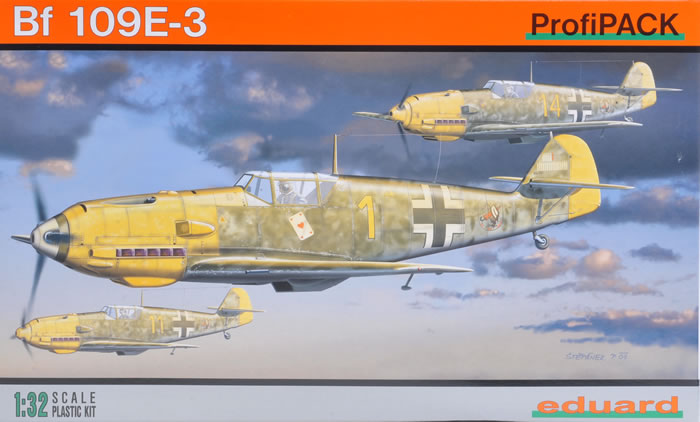
Eduard, 1/32 scale
S
u m m a r y |
| Catalogue Number: |
Eduard Kit No. 3002 - Messerschmitt Bf 109 E-3 Profipack |
| Scale: |
1/32 |
| Contents and Media: |
169 parts in olive coloured plastic; five parts in clear; two photo-etched frets (one in colour); canopy masks; markings for five aircraft plus full stencil data. |
| Price: |
USD$74.95 available online from Eduard
and hobby retailers worldwide |
| Review Type: |
FirstLook |
| Advantages: |
Very high level of detail including optional engine; restrained and impressive surface features; newly designed main wheels; separate control surfaces including flaps and leading edge slats; colour photo-etched parts; excellent quality decals with five colourful options |
| Disadvantages: |
A few sink marks. |
| Conclusion: |
A high quality 1/32 scale Messerschmitt Bf 109 E-3 that addresses one of the few concerns about the earlier E-1 - the wheels. A great kit that looks terrific when built, whether the engine on display or the cowl is fitted. |
Reviewed by
Brett Green

Eduard's 1/32 scale Messerschmitt Bf 109 E-3 is available online from Squadron.com
Background
The Messerschmitt Bf 109 A, B, C and D were powered by the Junkers Jumo engine. The Spanish Civil War presented the opportunity to test these revolutionary fighters in action, and they proved their worth in combat with Legion Condor over the skies of Spain.
The Messerschmitt Bf 109 E series was the first of the family to be fitted with the Daimler Benz DB601A engine, resulting in a significant improvement in performance.
Two variants were manufactured in parallel - the lightweight Bf 109 E-1 which retained the wing-mounted 7.9mm machine guns of the earlier Bf 109 B, C and D; and the Bf 109 E-3 which was fitted with one 20mm MG FF cannon in each wing. Both variants featured two additional 7.92mm machine guns in the cowl.

1,540 Bf 109 E-3s were delivered. They saw first saw service with Legion Condor in Spain, then continued in widespread action alongside the Messerschmitt Bf 109 E-1 in Poland, the Low Countries, across the English Channel in the Battle of Britain and in the Balkans.
Eduard released their all-new 1/32 scale Messerschmitt Bf 109 E-1 in February 2009. This excellent kit was well detailed and generally very accurate, including an engine that could be displayed, nicely detailed cockpit and gorgeously subtle surface features. A detailed review of this kit, including images of all the parts, may be found by following this link.
I built the Bf 109 E-1 kit back in March. You can find a Construction Feature on this model by following this link.
Eduard's Bf 109 E-4 followed in May this year. I also built this model. Follow this link to see it.
Let's take a look at the differences between the Eduard's first Bf 109 E releases and this E-3 kit.
What's New
Eduard's new 1/32 scale Messerschmitt Bf 109 E-3 comprises 169 parts in olive coloured plastic, eight parts in clear, two photo-etched frets (one in colour), canopy masks, markings for five aircraft plus full stencil data.
First, credit where credit it due. Eduard's earlier 1/32 scale Bf 109 kits came with main wheels with noticeably shallow cast rib detail inside the hubs. Eduard has now provided newly moulded wheels that address these issues. The new hubs look great, with deep separate rib detail. Well done Eduard.

This kit features the same wing as the Bf 109 E-4 kit, with the wing-mounted MG FF cannon bulges, panels and ports.
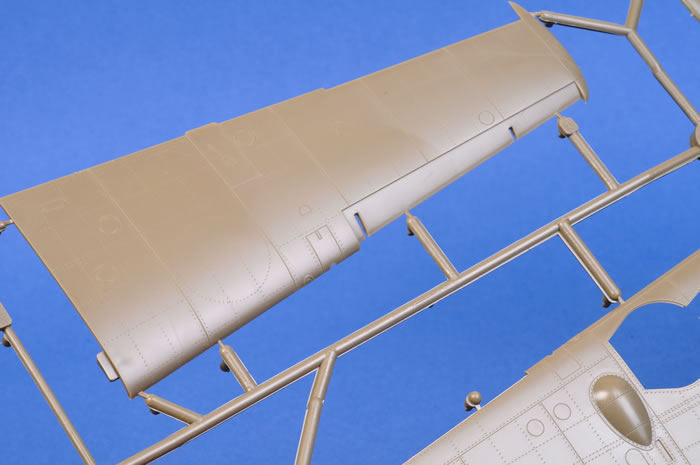
There are no inserts or cutouts required for the wing parts.
The ETC rack and 300 litre drop tank are supplied, but they are not called out for use with these marking options. Similarly, the plastic basis of a tropical air filter is on the sprues, but it looks like a future release will include a photo-etched surround to complete this version.
The early version canopy parts (the same as the E-1) are included for this variant. The shape, detail and clarity of this canopy is very good indeed.
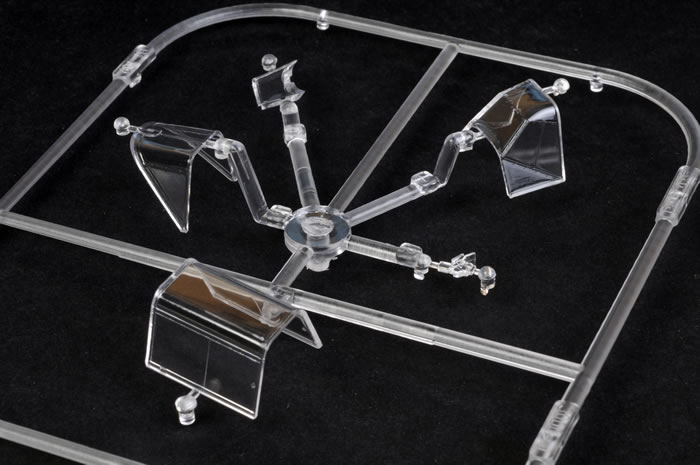
Two new photo-etched frets are supplied specifically for this variant.
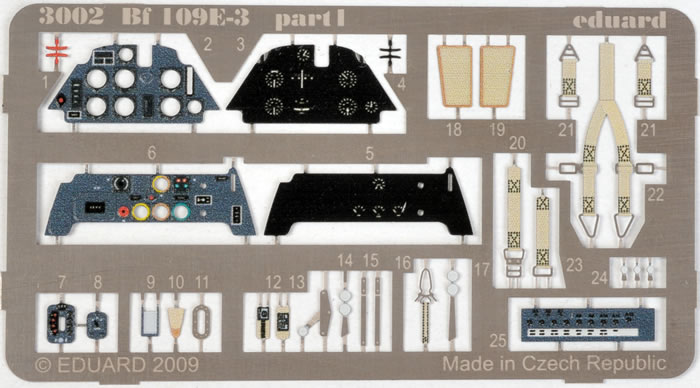
Colour photo-etched parts include the instrument panel sandwich, fuse panel and harness straps.
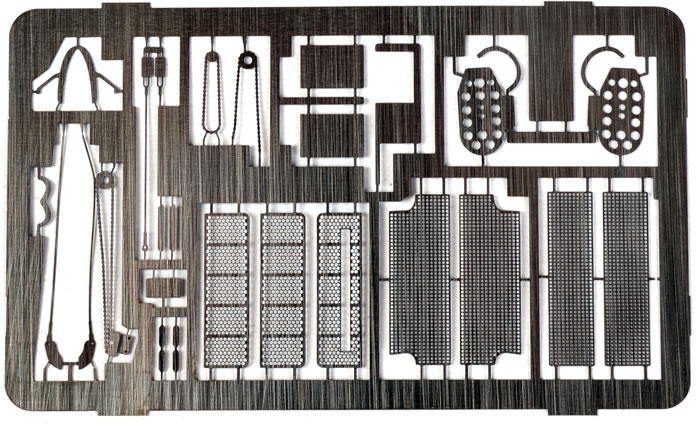
Five marking options are included for this release:
-
Oblt. Josef Priller, Staffelkapitän 6./JG 51, France, Autumn 1940
-
3./JG 51, Mannheim-Sandhofen, Winter 1939-1940
-
1./JG 2, Bassenheim, Germany, May 1940
-
Obstlt. Hans-Hugo Witt, Geschwaderkommodore JG 26, Dortmund, Germany, April 1940
-
Uffz. Karl Wolff, 3./JG 52, Pihen/Calais, France, August 1940
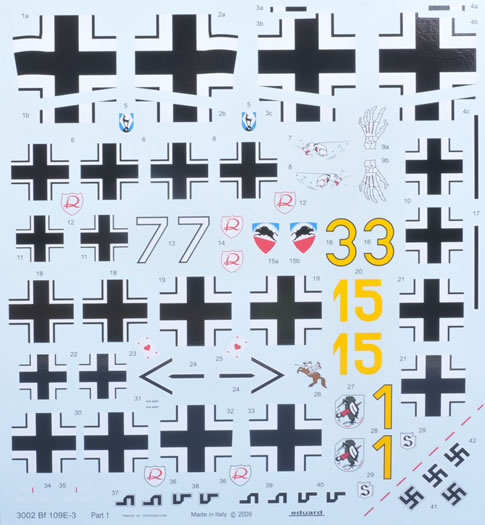
Two decal sheets are included. The umbo-sized first sheet contains the main aircraft markings and the second supplies a full set of stencils. A number of alternatives are included on the stencil sheet.
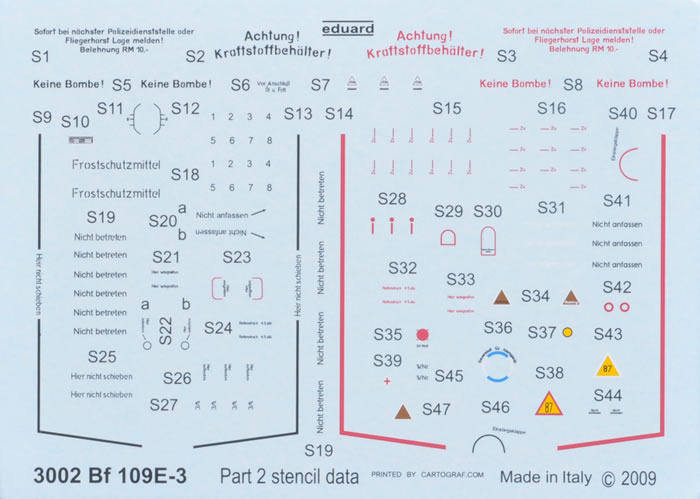
Decals have been printed by Cartograf. Register is perfect, colours are rich and opaque, and visible carrier film is non-existent. They don't come much better than these. I particularly like the interpretation of RLM 04 Yellow on this sheet .
The kit in detail
With the specifics of the new kit covered, let's take a look at the kit in general.
Plastic parts are very well moulded, with only a few shallow sink marks that will be visible on the finished model (most notably the front of the top wing halves near the wing roots).
Surface detail is state-of-the-art. Finely recessed panel lines are supplemented with even finer rows of rivets. These are barely visible at some angles, and are consistent over the whole airframe. Very nice indeed. Control surfaces feature raised "fabric strips" and stitching. Lighting for photography seems to exaggerate the effect, but they look great on the sprues. Even so, if the fabric sag is too much for your personal taste, it will be a simple matter to fill the recesses with Mr Surfacer, or lightly sand the raised ribs.
Detail is excellent. The plastic cockpit parts are combined with colour and nickel-plated photo-etch to deliver an authentic front office. Note that the oxygen bottle is a little too high. This can easily be improved by cutting the bottom two rows of perforations.
A full engine is supplied, but this is an optional element. Eduard has taken notice of customer comments about the complexity of some of its earlier kits including the 1/48 scale Fw 190 and Bf 110 families. In the case of this 1/32 scale Bf 109 E-3, the DB601A engine may be installed and displayed, or the cowl may be glued closed without the engine. Alternate parts are supplied to mount the propeller, the exhaust stubs and the cowl guns if the second option is chosen.
The engine looks good. Individual exhaust stubs are provided. These are hollow at the end and have raised weld seams down the middle - don't sand these off!
The cowl itself is supplied in four pieces - the main upper cowl, two rear side cowl panels and the gun deck.
All control surfaces are separate - the flaps, leading edge slats, ailerons, elevators and rudder. The rudder actuator is provided in photo-etched metal. Flaps are moulded with tabs that will pose them dropped without modification, but it will be very easy to slice off the tabs and reposition if desired.
The oil cooler and wing radiator front and rear faces are all supplied as photo-etched grilles.
The ceiling of the well features a ring of raised rivets and reinforcement strips. The sides of the main wells are boxed in with separate parts.
The self-adhesive canopy masks are a time-saving touch.
So did we really need another Bf 109?
Oh yeah!
Eduard has filled another important gap in the Luftwaffe modeller's repertoire with their 1/32 scale Messerschmitt Bf 109 E-3. It is great to see Eduard filling out their large scale Emil family.
Eduard should also be congratulated for reworking the main wheels. The brand new items are a great improvement over the two-dimensional offerings in previous releases.
Eduard's 1/32 scale Messerschmitt Bf 109 E-3 is very well detailed straight from the box, and the modeller has the choice of tackling the engine or simply buttoning up the cowl. Having already built the two earlier releases, I expect that this model will be quite straightforward in construction, and lots of fun to paint!
Thanks to Eduard for the sample
Review Text & Images Copyright © 2009 by Brett Green
Page Created 30 November, 2009
Last updated
1 December, 2009
Back to HyperScale Main Page
Back to Reviews Page |
